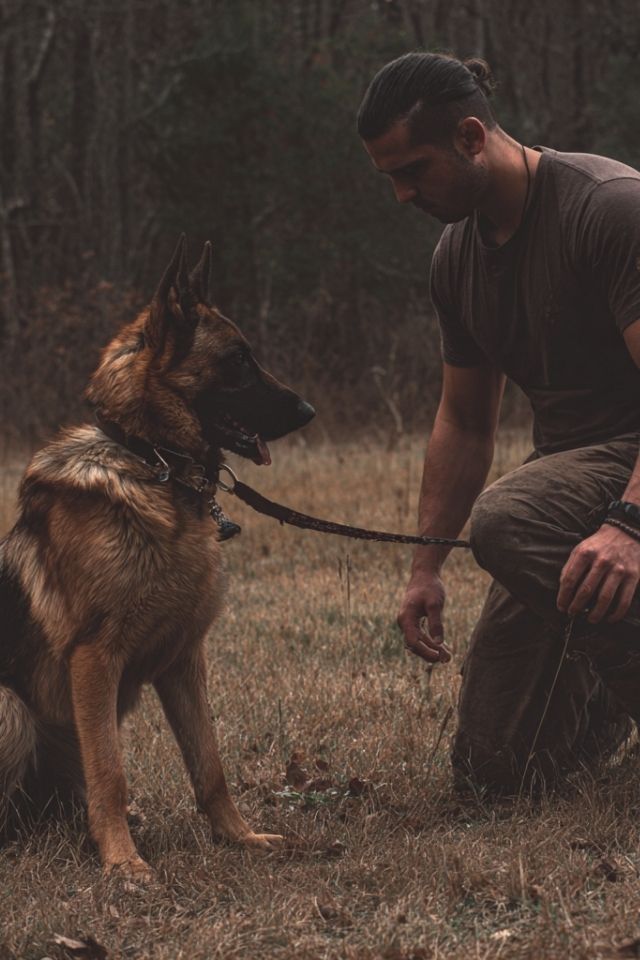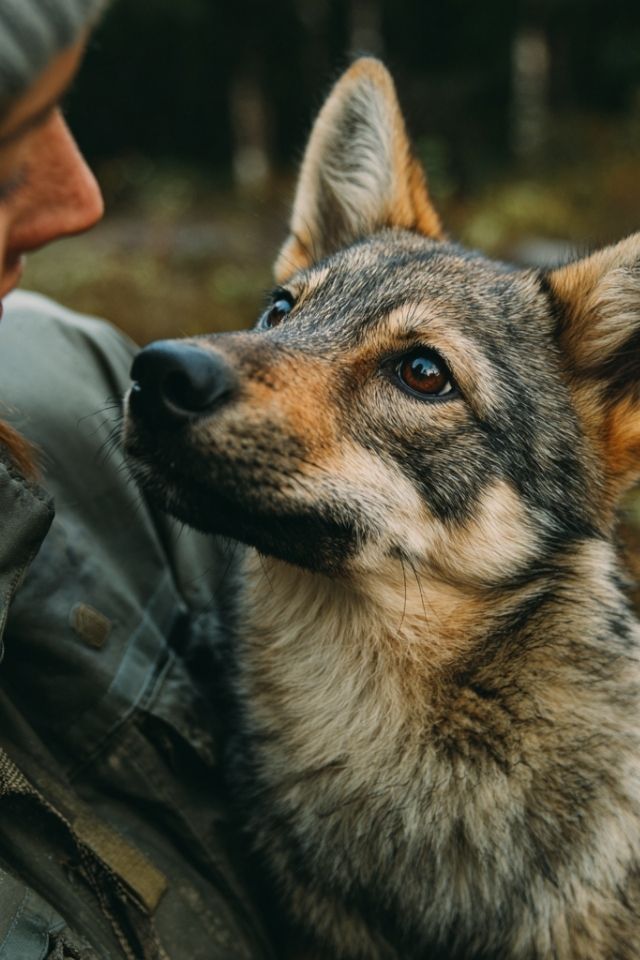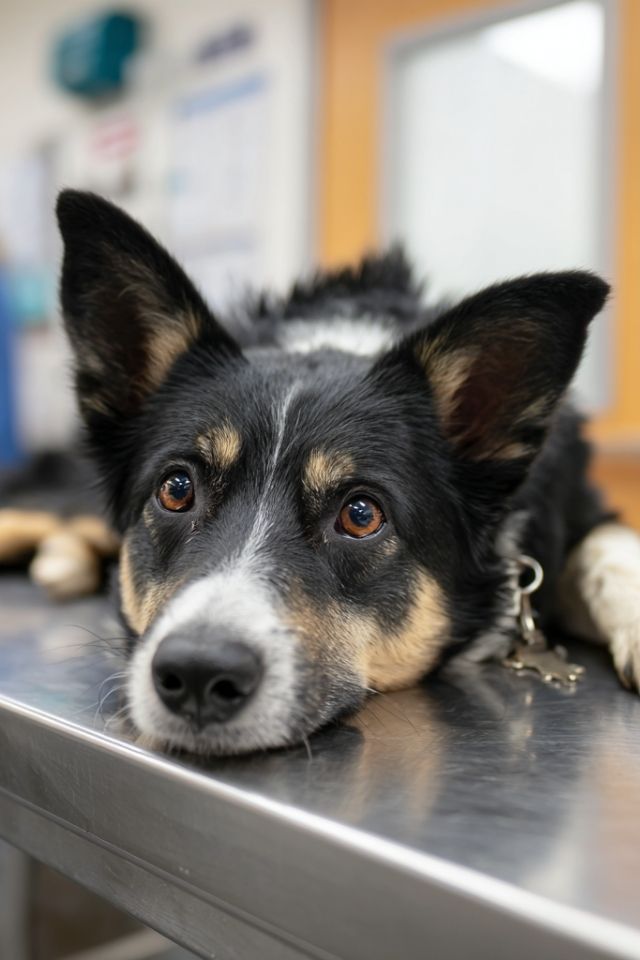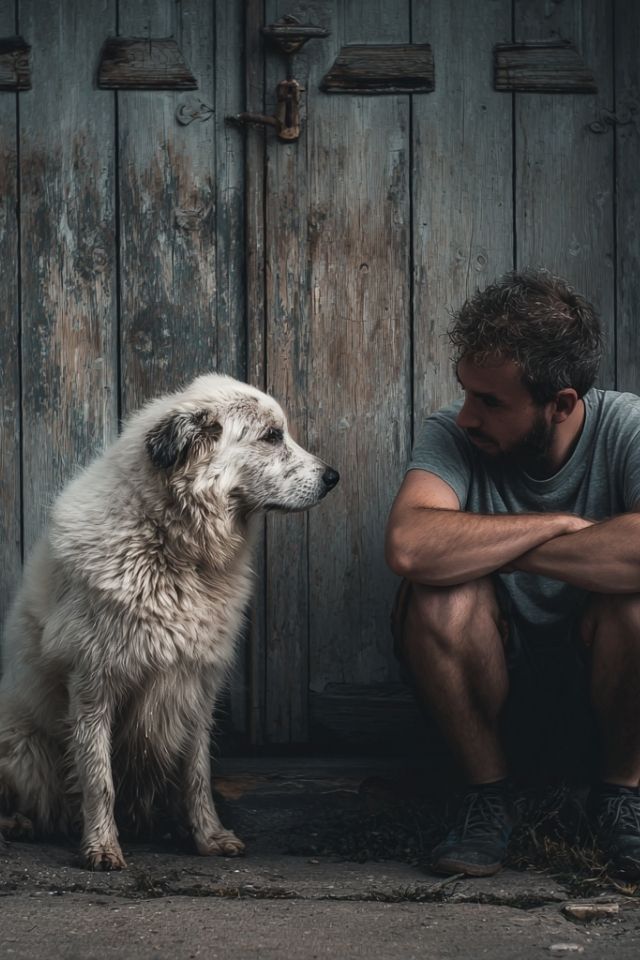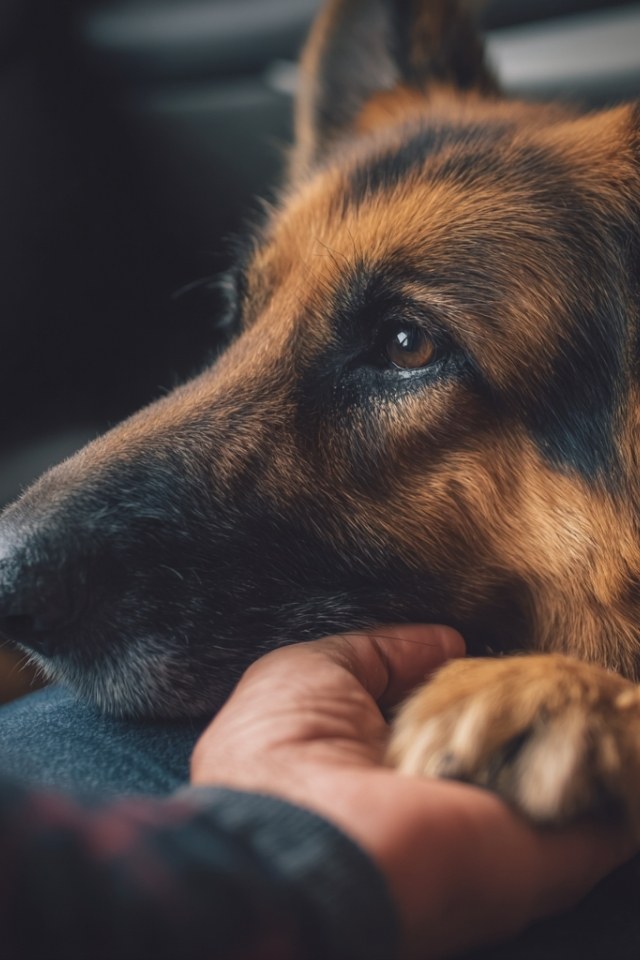There’s a moment every reactive dog owner knows too well. You’re walking down the street, and everything feels almost normal—until it doesn’t. Your dog’s body shifts. The muscles along their spine go rigid. Their gaze locks onto something in the distance, and suddenly the leash in your hand transforms from a simple connection into a wire humming with tension. Your heart drops. You know what’s coming.
The lunge. The bark. The explosion of sound and movement that makes passersby step back and leaves you feeling like you’ve failed at the most basic thing: taking your dog for a walk.
But here’s what most people don’t see in that moment—what you yourself might not recognize: your dog isn’t being aggressive. They’re drowning in frustration so intense it rewrites their entire nervous system in real time. And that six-foot leash? It’s not just holding them back. It’s amplifying everything.
Let us walk beside you through this. Not with judgment, but with understanding. Because what looks like a training problem is actually a window into your dog’s emotional world—and once you learn to see through it, everything changes. 🧡
The Fire Inside: What Happens When Desire Meets Restraint
Picture this: your dog sees another dog across the street. In that instant, their brain lights up like a night sky. The SEEKING system—an ancient neural pathway powered by dopamine—floods them with a singular, consuming drive. I need to get there. It’s not a choice. It’s not defiance. It’s biology singing so loud it drowns out everything else.
This is the same system that makes wolves track prey across frozen tundra, that makes wild dogs search for water in drought, that drives every mammal toward what it needs. When that system activates, your dog’s entire being becomes oriented toward a single point in space. The world narrows. Focus sharpens. Every fiber says go.
And then—they can’t.
The leash stops them. Not gently. Not gradually. Just stops. And in that collision between overwhelming drive and immovable barrier, something ruptures inside. Frustration doesn’t build—it detonates.
Their body floods with cortisol and adrenaline. The sympathetic nervous system kicks into overdrive. Heart pounding. Muscles coiled. Breath quickening. Every signal screaming act, now, do something—but there’s nowhere to go. No way to release the pressure building inside them like steam in a sealed vessel.
Researchers call this the frustration-aggression hypothesis. When goal-directed behavior gets blocked, emotional arousal doesn’t just increase—it transforms. What began as curiosity or excitement or social interest becomes something that looks, feels, and sounds like rage. But it’s not. It’s thwarted desire turning itself inside out, searching desperately for an outlet it cannot find.
This is the neurobiology of leash reactivity. And through the NeuroBond approach, we learn to see it not as behavior to punish, but as communication to understand. Your dog is telling you they’re overwhelmed. They’re telling you the world feels impossibly far away and impossibly close all at once. They’re telling you they’ve run out of ways to cope. 🧠
The Wire That Connects and Divides
Here’s something most handlers miss: that leash in your hand isn’t just a physical tool. It’s a living connection that transmits emotion in both directions, like a telephone wire carrying voices you can’t quite hear but somehow feel.
When you see that other dog approaching and your shoulders tense—when your grip tightens and your breath catches and your mind starts racing through worst-case scenarios—your dog feels it. All of it. The tension travels down the leash before you’ve even consciously registered your own anxiety. Your dog reads it in the subtle shift of pressure, in the way your body stiffens, in the energy that suddenly crackles between you.
And they respond. Not to the other dog yet, but to you. To your fear. To your anticipation of disaster.
This is what we mean by the Invisible Leash—that awareness, not tension, guides the path. The physical leash might be six feet of nylon, but the invisible one is made of attention, energy, and the emotional frequency you’re broadcasting. Your dog is tuned to that frequency like a radio, receiving every signal you send whether you mean to send it or not.
The feedback loop begins: your tension increases their arousal. Their arousal increases your tension. Round and round it spirals, each feeding the other, until the actual trigger—that other dog, that bicycle, that jogger—is almost secondary to the electrical storm building between you.
Research on the dog-owner relationship tells us this bond is powerful enough to affect mental health, stress hormones, and well-being in both species. When that bond becomes a conductor of anxiety rather than calm, both ends of the leash suffer. But when you learn to send different signals—groundedness, awareness, quiet confidence—the entire system can shift.
Your dog doesn’t need you to fix everything. They need you to be the eye of the storm. The still point they can orient toward when their own nervous system is spinning out of control.
When Memory Becomes Prison
After the first reactive episode, something subtle begins. After the fifth, the tenth, the twentieth—it becomes architecture. Your dog’s brain is reshaping itself around this experience, building neural pathways that connect “leash” with “frustration” and “other dogs” with “impossible desire.”
This is where Soul Recall enters the story—that deep, embodied memory that lives not just in your dog’s mind but in their muscles, their nervous system, their very cells. Every time they explode at the end of the leash, they’re not just reacting to what’s happening now. They’re reacting to every time it happened before, all those moments compressed into a single, overwhelming now.
The amygdala—that ancient alarm system buried deep in the brain—learns to light up faster each time. The threshold lowers. What once took intense provocation now happens at the mere glimpse of movement in the distance. The prefrontal cortex, which should pause and assess and choose a different response, starts going offline under stress. Impulse control crumbles. Inhibition fails.
Studies on chronic stress show us that this isn’t weakness. It’s adaptation. Your dog’s brain is doing exactly what brains do: optimizing for survival in an environment it perceives as threatening. The problem is, it’s optimizing for the wrong thing, strengthening patterns that increase suffering rather than reducing it.
You might notice your dog tense the moment you reach for the leash now, before you’ve even left the house. That’s anticipatory frustration—a kind of pre-traumatic stress where the memory of what’s coming creates the reaction before the trigger even appears. The leash itself becomes a predictor of pain. The walk becomes something to dread rather than enjoy.
This is the hard truth about leash reactivity: left unaddressed, it doesn’t plateau. It deepens. Each episode carves the groove a little deeper, makes the pattern a little more automatic, moves it further from conscious choice and closer to reflex. 🐾
Reading the Language Before the Storm
But here’s where hope enters. Because reactivity doesn’t truly explode out of nowhere. There’s always a language being spoken in the seconds before—subtle shifts in your dog’s body that whisper warnings if you know how to listen.
Watch for the moment their gaze changes. That soft, scanning attention suddenly becomes a laser—fixed, hard, unblinking. The world contracts to a single point. This is fixation, the first sign that their SEEKING system has locked onto a target.
Then the body follows. Muscles along the spine go taut. The neck extends. Movement that was fluid becomes mechanical, like a machine shifting into a different gear. Some dogs plant their feet and refuse to budge. Others surge forward with sudden force. Both are saying the same thing: arousal is building and I’m losing the ability to modulate it.
Breathing changes next. Watch their sides. Some dogs begin to pant rapidly even in cool weather, quick shallow breaths that signal sympathetic activation. Others hold their breath entirely, every system bracing for action.
The tail tells its own story. For frustration-based reactivity, it goes high and stiff, or beats back and forth in rapid, mechanical strokes. Not the loose, sweeping wag of joy—this is tension made visible, energy with nowhere to go.
These signs are your window. The moment between “noticing” and “exploding” where intervention is still possible, where your dog’s prefrontal cortex is still online enough to respond, to choose, to learn something new.
Once the explosion happens—the lunging, the barking, the full-body strain against the leash—you’re in damage control. Your dog is over threshold, flooded with stress hormones, with their thinking brain offline and only the ancient, reactive brain in charge. Nothing you say or do in that moment teaches them anything except that this feeling is even more overwhelming than they thought.
But catch that first fixation? Redirect at the body stiffening? Create distance when you see the hard stare? That’s where transformation lives. Not in managing the explosion, but in preventing the conditions that make explosion inevitable.
Two Dogs, Two Stories
Let me show you the difference between frustration and fear, because they wear similar masks but have entirely different hearts.
Meet Luna, a young Labrador who pulls toward every dog she sees. Body forward, tail high, eyes bright with intensity. She barks—loud, insistent, demanding. Let me GO. I need to GET THERE. When she can’t, she whirls and bites at the leash, jumps on her handler, redirects all that explosive energy anywhere it can land. But once the other dog passes? She settles within minutes, tail wagging again, ready to continue the walk as if nothing happened.
Luna is frustrated. She wants to approach, to investigate, to engage. The leash blocks her from something she desperately desires, and the thwarted drive has nowhere to go but outward.
Now meet Cooper, an anxious shepherd mix. When he sees another dog, his body also goes tense—but differently. His weight shifts backward, not forward. His ears flatten. His eyes show whites at the edges. He barks too, but it’s higher pitched, more frantic. Stay AWAY. Don’t come CLOSER. If the other dog approaches despite his warning, Cooper’s body language screams conflict: he wants to flee but can’t, so he lunges forward in defensive threat. After the encounter, he remains vigilant for long minutes, unable to settle, scanning for the next threat.
Cooper is afraid. He wants distance, safety, escape. The leash traps him in proximity to what he perceives as danger.
Both dogs lunge. Both bark. Both pull at the end of the leash. But their emotional experiences are utterly different, and so must be our responses. Luna needs to learn frustration tolerance and impulse control. Cooper needs to feel safe and learn that other dogs don’t predict harm.
Misread which dog you’re working with, and your intervention can make everything worse. 🧡
The World Itself as Amplifier
The environment where you walk isn’t neutral. It’s an active participant in your dog’s nervous system, either supporting regulation or making it nearly impossible.
Picture an urban street at rush hour. Car horns blast. Construction jackhammers pound. Crowds press close on narrow sidewalks. Bicycles whip past with no warning. Other dogs appear around blind corners at close range, giving neither you nor your dog time to prepare. The concrete landscape offers no refuge, no soft places, no choice but to keep moving forward through the gauntlet.
Your dog’s baseline arousal in this environment is already elevated before a single trigger appears. They’re starting from seventy percent capacity, which means it takes almost nothing to push them over threshold into reactivity. Every sense is overwhelmed. Every moment feels unpredictable. The world itself becomes a stressor.
Now picture a quiet trail in early morning. Space stretches out in all directions. Sight lines are long—you can see other dogs coming from hundreds of feet away. Natural sounds buffer the sensory input. The earth beneath your dog’s paws grounds them. Interesting smells invite calm investigation. When another dog appears, there are options: move to the side, increase distance, let your dog process from safety.
Same dog. Same underlying reactivity pattern. Completely different capacity to cope.
Research shows that changes in human lifestyle and increasingly urbanized environments significantly affect canine well-being. We’ve created spaces optimized for human convenience and efficiency, but they’re often sensory nightmares for sensitive dogs. Add a reactive dog to that equation, and you’re asking them to maintain emotional regulation in conditions that would challenge even the most stable animal.
This doesn’t mean reactive dogs can never walk in cities. It means we need to acknowledge the environmental load and adjust our expectations accordingly. Sometimes the most therapeutic thing you can do is drive your dog to a quiet space where their nervous system can experience what calm feels like again.
The Paradox of Learning
Here’s something that surprises most handlers: the very thing that seems to work—your dog occasionally reaching the other dog, or the other dog moving away—is actually strengthening the problem.
This is intermittent reinforcement in action, and it’s the most powerful schedule for creating persistent behaviors. Think of a slot machine. You don’t win every time. But you win just often enough to keep pulling that lever, to keep hoping, to keep trying. The unpredictability itself becomes addictive.
For your reactive dog, maybe nine times out of ten, the explosive display achieves nothing. But that tenth time? The other dog walks away, or the handler changes direction, or the leash breaks free for just a moment. That single success—it worked, I got what I wanted—reinforces every lunge, every bark, every strain against the leash that preceded it.
Your dog’s brain learns: keep trying. It works sometimes. Don’t give up.
This is why reactivity is so maddeningly persistent. Why months of careful training can seem to evaporate in a single encounter. Why your dog keeps rehearsing the pattern even though it brings them more frustration than satisfaction. The occasional win keeps the whole system running.
The good news is that learning works both ways. If intermittent reinforcement can strengthen reactivity, consistent reinforcement can build something new. But it requires preventing those occasional “wins” while creating abundant reinforcement for the behaviors you want instead. It requires patience to play the long game while the old pattern slowly, gradually loosens its grip.
Beyond Commands: Meeting Emotion with Understanding
If you’ve spent months drilling “sit,” “watch me,” “leave it”—only to have those commands evaporate the moment another dog appears—you’re not alone. And you’re not failing. You’re just using cognitive tools to address an emotional problem.
Commands require executive function. They live in the prefrontal cortex, the part of the brain that plans, chooses, inhibits impulses. But when your dog is flooded with stress hormones, when their amygdala is screaming danger, when their entire nervous system is in fight-or-flight mode? The prefrontal cortex goes offline. It’s like asking someone having a panic attack to solve algebra. The neural systems required simply aren’t accessible.
Through the NeuroBond approach, we learn that transformation happens not by commanding compliance but by teaching emotional regulation. Not by demanding your dog ignore their feelings, but by helping them develop the capacity to feel those feelings without being consumed by them.
This looks different than traditional training. Instead of drilling commands at close range to triggers, you work at distances where your dog can notice the trigger and remain calm—where their thinking brain is still online. Instead of demanding constant attention on you, you allow them to look at triggers and practice calm assessment. Instead of pushing through reactivity until they “get over it,” you respect their threshold and build capacity gradually.
Research on dogs with behavioral disorders shows that interventions addressing physiological stress—whether through diet, environmental management, or training methods that reduce frustration—improve outcomes by supporting better neuroendocrine balance. When you lower cortisol and support dopamine and serotonin naturally, behavior changes more readily because the emotional foundation is healthier.
This is where the Invisible Leash becomes real: when guidance comes through understanding rather than force, when your dog learns that you’re reading their signals and responding with support rather than correction, something profound shifts in how they experience the world. 🧠
Choice, Distance, and the Dance of Regulation
Imagine working with your reactive dog at a distance where they can see another dog but aren’t yet pulling. You notice their attention sharpen, their body tense slightly. Instead of immediately redirecting or correcting, you wait. You give them a moment to notice, to assess, to feel their own response.
If they look and then look back to you—you mark that instant and reward it. If they choose to keep watching but remain calm—you reinforce that calm observation. If they want to take a step closer—you allow it, watching carefully. And when they offer a voluntary glance away, a check-in, a moment of choosing you over the trigger, you celebrate that choice like gold.
This is structured choice in action, the approach-retreat protocol that respects your dog’s emotional state while building new patterns. Your dog learns something radical: they have agency. The presence of triggers doesn’t automatically mean frustration and restriction. It means a conversation, an opportunity to practice choosing calm, a chance to discover that they can influence what happens through their own behavior.
Distance is your most powerful tool here. Find the space where your dog can perceive the trigger without being overwhelmed—what behaviorists call sub-threshold. For some dogs, that’s fifty feet. For others, two hundred. Neither is better or worse. Both are simply meeting your dog where they are.
As your dog practices calm assessment at distance, something beautiful happens. New neural pathways form. The amygdala learns that other dogs don’t predict frustration or conflict. The prefrontal cortex strengthens its ability to pause, assess, choose. The space between stimulus and response—that precious gap where freedom lives—begins to widen.
Duration matters too. Even at safe distance, prolonged exposure can cause arousal to accumulate. Short sessions with recovery time between them teach more effectively than forcing your dog to endure until they collapse into exhausted compliance.
And intensity—the characteristics of the trigger itself—gives you another dimension to modulate. A calm dog at a distance is lower intensity than an aroused dog up close. Single triggers are easier than multiple. Controlled encounters beat unpredictable ones.
You’re not just training behaviors. You’re rebuilding your dog’s entire relationship with the world, one carefully calibrated exposure at a time. 🐾
The Handler’s Inner Work
While we focus on the dog’s emotional state, there’s another nervous system in this equation: yours. And your dog is exquisitely tuned to it.
Research on the dog-owner relationship shows that the bond affects both parties’ well-being. When you experience your dog as a burden, when walks fill you with dread, when every encounter feels like potential disaster—your dog feels that. They feel your tension before you’re consciously aware of it yourself. They respond to your energy before the trigger even appears.
This isn’t about blame. It’s about recognition. The work of transforming leash reactivity asks as much of you as it does of your dog. It asks you to notice when your own shoulders tighten, when your breath goes shallow, when your mind starts catastrophizing. It asks you to find your own ground, your own calm center, so you can be the regulated presence your dog needs to borrow when their own system is overwhelmed.
Some days you’ll succeed. Other days you won’t. On the hard days, remember: your dog doesn’t need you to be perfect. They need you to be present. They need you to keep trying, keep learning, keep believing that change is possible even when the evidence feels slim.
This is co-regulation—the dance where your nervous system helps stabilize theirs, where your calm creates a field of safety they can step into. It’s not magic. It’s biology. And it’s one of the most powerful tools you have.
The Long Path Home
I won’t tell you this work is easy. I won’t tell you it’s fast. Behavior change—real, deep, lasting change that rewrites neural pathways and transforms emotional patterns—happens slowly. It happens in small increments that sometimes feel invisible. It happens through hundreds of repetitions of new patterns gradually overwriting old ones.
Some days you’ll feel like you’re making progress. Other days you’ll wonder if anything is changing at all. And then, weeks or months later, you’ll suddenly realize: your dog saw another dog and looked to you instead of exploding. They held it together through an entire walk that would have been impossible three months ago. The threshold for reactivity has widened, even if just by inches.
Through Soul Recall, we understand that you’re not just training new behaviors. You’re creating new memories. New emotional experiences that layer over the old ones, gradually building a different story about what walks mean, what other dogs predict, what’s possible when desire meets limitation.
Your reactive dog isn’t broken. They’re not bad. They’re not damaged beyond repair. They’re a sensitive being who learned that the world is frustrating, that their needs won’t be met, that the only way to cope with overwhelming drive is explosive display. And they can learn something different—but only if we meet them with patience, understanding, and the unwavering belief that beneath the reactivity lives a dog yearning for the same thing you are: connection, safety, and walks that feel like joy instead of battle.
That balance between science and soul, between precise intervention and deep emotional attunement, between managing behavior and honoring the being beneath it—that’s the essence of Zoeta Dogsoul.
The path forward is there. It’s marked by small victories and occasional setbacks, by celebration and frustration, by moments of breakthrough and long stretches of steady, unglamorous work. But it’s there. And you don’t walk it alone.
Every step forward, no matter how small, is a triumph worth celebrating. 🧡🐾
